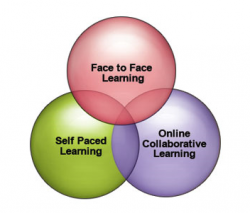Franklin University conducted yet another study on Hybrid Learning. The Franklin Hybrid model consisted of remote meeting software, audio and video mixing hardware, and a structured curriculum design to integrate face-to-face students and online students in the same class. The classes were remote live sessions accompanied by asynchronous learning activities. Some of the off-the-shelf technology used were: -
Resources for you to explore
- A computerized classroom with PCs for each face-to-face student
- A projection system, preferably one that permits control of the computer from the
screen, such as a SMART Board™ - A wireless lavaliere microphone and mixer tied into the instructor's computer
- Wireless microphone/speaker combination for each face-to-face student
- Web meeting software and
- A web-cam that is compatible with the web meeting software.
Resources for you to explore


